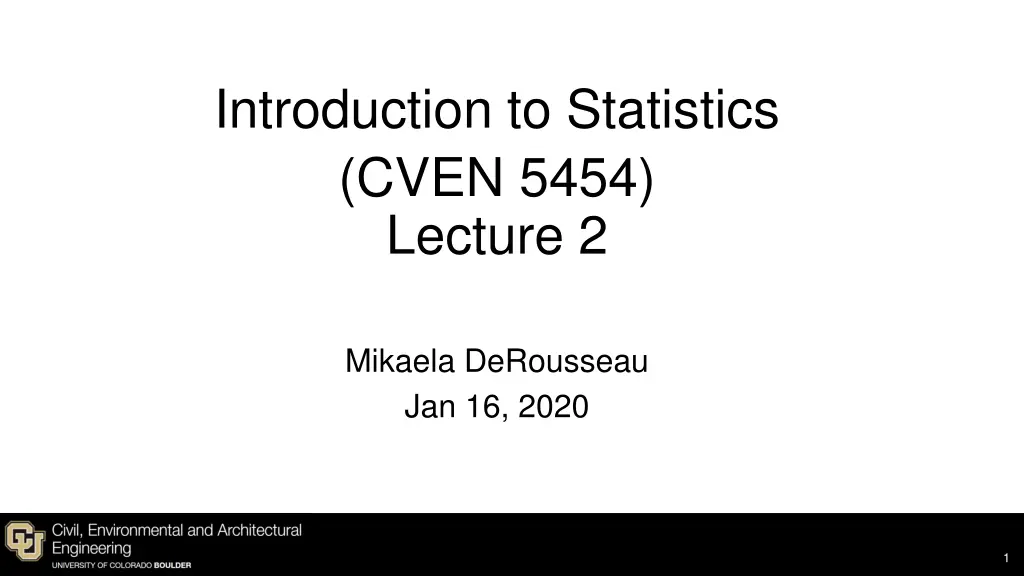
Understanding Statistics: Measures and Analysis Techniques
Explore the fundamentals of statistics, including measures of location and spread, using statistical analysis tools like R to interpret data effectively. Learn how to summarize and interpret data sets to derive valuable insights for decision-making.
Download Presentation

Please find below an Image/Link to download the presentation.
The content on the website is provided AS IS for your information and personal use only. It may not be sold, licensed, or shared on other websites without obtaining consent from the author. If you encounter any issues during the download, it is possible that the publisher has removed the file from their server.
You are allowed to download the files provided on this website for personal or commercial use, subject to the condition that they are used lawfully. All files are the property of their respective owners.
The content on the website is provided AS IS for your information and personal use only. It may not be sold, licensed, or shared on other websites without obtaining consent from the author.
E N D
Presentation Transcript
Introduction to Statistics (CVEN 5454) Lecture 2 Mikaela DeRousseau Jan 16, 2020 1
Personal Introduction Ph.D. student with Civil Systems focus Research: Developing a new (computational) method for designing concrete that minimizes carbon dioxide emissions of the built environment Advised by Joe Kasprzyk and Wil Srubar 2
Lecture Outline Part I (normal lecture, brief) Introduce basic statistical measures (mean, median, standard deviation, IQR, skew, etc.) Part II (using R) Basic concepts of using R Show how to calculate above statistical measures in R Generate boxplots, histograms, and scatterplots in R and understand their meaning Extra tips for succeeding in this class 3
Statistics: figuring out what we can learn from a dataset Measurements of total organic carbon (TOC) values in ppm: [21 18 43 21 11 18 22 19 24 25 15 20 26 23 22 18 27] We can use simple statistical measures to characterize/summarize the data 4
Measures of Location ? Median = the 50th percentile of the data (P.50) (Central value of the distribution when data are ranked in order of magnitude) Mean ( ?) = ?=1 ?? ? (xi = each data value, n = sample size) TOC Values (ppm) Mean Median [21 18 43 21 11 18 22 19 24 25 15 20 26 23 22 18 27] [2000 18 43 21 11 18 22 19 24 25 15 20 26 23 22 18 27] Mean 21.9 Median 21 138.4 22 When might it be important to show both measures of location? 5
Measures of Spread \ ? (?? ? )2 ? 1 Variance (s2) = ?=1 Standard deviation (s) = ?2 *Note: when you start talking about populations (as opposed to samples, you ll see the notation: . 6
Measures of Spread, continued \ Interquartile range (IQR) = range of the central 50% of the data Outlier-resistant! (75th percentile 25th percentile) TOC Values (ppm) St. Dev. IQR [21 18 43 21 11 18 22 19 24 25 15 20 26 23 22 18 27] [2000 18 43 21 11 18 22 19 24 25 15 20 26 23 22 18 27] Mean 6.75 Median 6 479.8 7 When would it be important to show both measures of spread? 7
Measures of Skewness How would you describe a skewed dataset? Extreme values extending out further in one direction ? (?? ?)2 ?3 Skew (g) = ?=1 Symmetric data Positively skewed data Do you expect water resources and environmental concentration data to tend to be positively or negatively skewed? 8
Introduction to R and R Studio Download R: https://www.r-project.org/ Download R Studio: https://rstudio.com/products/rstudio/download/ Supplementary R tutorials and information: Online Book, R for Data Science - https://r4ds.had.co.nz/ R cheatsheet https://rstudio.com/wp-content/uploads/2016/10/r-cheat- sheet-3.pdf When all else fails, google it! 9






















